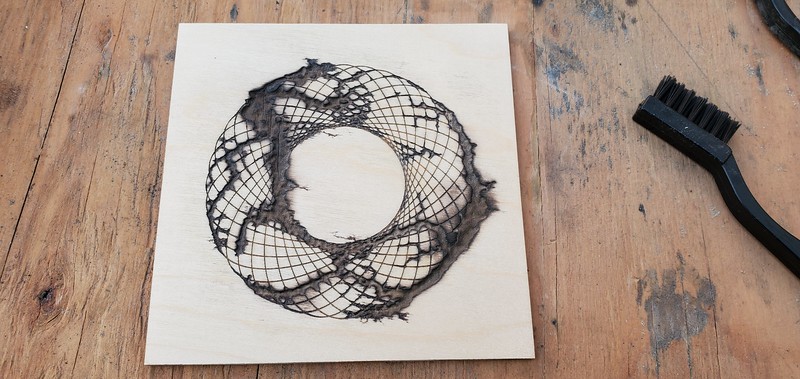Louie Garcia (skillful electrician, Chair of Building Industries at Sierra College, and all-around inspiring maker) held a make-and-take workshop today on Lichtenberg wood burning machines as part of a Train the Trainer series organized by longtime supporter of regional manufacturing education Steve Dicus. Assembled from old microwave parts and assorted electrical castoffs – Louie is a true believer in creative reuse – each participant was able to build, test, and take their setup home. Suffice it to say that Lichtenberg wood burning can be a pretty dangerous endeavor, and is not to be trifled with, but Louie did a great job explaining the safe construction and operation of the system.
My rig assembled and functional, I started wondering about using the laser cutter to etch a “suggestion” for the water to flow and by extension the electricity to follow, so I headed to the Innovation Center for some prototyping. To set up a very basic test, I created a file in Illustrator with simple lines from 1 pt to 7 pt. This I burned on hobby plywood using Danger Scissors (our big laser). I mixed up a solution of baking soda and water, using a syringe to apply the solution to the work piece, then hit it with the Lichtenberg burner.
Electricity seeks the path of least resistance, e.g., the water, so it more or less did exactly what I predicted it might (though with some welcome unpredictability)! We have a tradition in the IC of making Nova (our space bunny mascot) with any new piece of equipment or technology, so that was my next test.
So far, so good. I decided to try something with more intricate lines.
Here’s the finished piece.
I’m really pleased with it – I love the juxtaposition of the precise lines of the laser and the organic and semi-unpredictable path of the electricity. For my next prototype, I decided to try some red oak, which I sanded and finished with some cutting board oil after burning.
Now that I have an understanding of the process, the next step (I think) will be configuring the system with safety and throughput in mind. This video of a no-touch version has some ideas worth exploring, particularly in terms of making the process more practical and safe, and I’m looking forward to continuing to iterate on the setup and the process.





